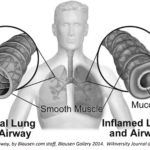MRSA: What is It? What Can Be Done About It?
The following article first appeared in Prison Legal News – Issue 25, Summer 2015: http://fight.org/wp-content/uploads/2015/09/PHN-Issue-25.pdf
METHICILLIN RESISTANT STAPHYLOCOCCUS AUREUS
(MRSA) is a complicated bacterial skin infection that is often resistant to many different types of antibiotics, including but not limited to penicillins and cephalosporins.
SIGNS AND SYMPTOMS
MRSA manifests most frequently as small bumps that look like pimples; then a boil or abscess will form. The area may be tender and painful, as if you are being burned by a cigarette. The skin may be hot, red, and swollen. It can feel hard because the infection has caused edema, which is the accumulation of fluid in the tissue.
If you are experiencing what’s described above, it would be a good idea to mark the border of the hard skin (edema) with a pen or marker and note the time. (If the infection is progressing, the edematous area will become larger. If it is clearing up, it will reduce in size. You will be able to note the progress by marking the border of the edema.) Report what you’ve found as soon as you can to medical staff. Don’t let medical staff off too easily if they tell you “You’re fine you don’t have a fever.” Absence of fever does not exclude an intection. If they make you jump through hoops to see them or tell you to make a sick call do it! Be sure to inform them that you believe it’s MRSA based on the symptoms. MRSA usually does not clear up on its own.
Certain people are more at risk of MRSA infection, including but not limited to: people who share gym equipment, people living in crowded conditions, older people, and people living with HIV/AIDS and/or diabetes.
TREATMENT
There are two basic principles to treat MRSA:
1) elimination of the focal infection.
2) administration of systemic antibiotics.
To attempt to eliminate the focal infection, a health care professional would first apply a hot compress to the area in order to encourage the abscess to come to a head. When the center of the abscess appears white to yellow, it is ready. They will either apply pressure to the sides of the boil or lance the head of the boil with something sterile until the abscess ruptures. At this point, they would remove all pus, dead tissue and debris by applying continuous pressure to the sides of the abscess until clean blood or clear fluid starts to come out.
They should take note that when attempting to drain the abscess, they will not be able to drain all of the edema. This does not mean that there is still pus in the abscess. The hardness is the fluid that accumulated in the tissue around the abscess and is a part of the normal immune system response.
Because the MRSA bacteria is contained in the pus, dead tissue, debris, and blood from the site, all materials are infectious. Therefore, the skin and materials should be thoroughly cleaned with hot water and soap, the skin should be covered with a clean bandage, and materials should be disposed of properly.
MRSA is resistant to many of the standard antibiotics. But drugs such as Bactrim (trimethoprim-sulfamethoxazole) and Cleocin (clindamycin) can work well against MRSA. For very serious infections, vancomycin (500 mg every 6 hours or I g every 12 hours) is given intravenously. Elevation of the affected area can help reduce edema. Cool, clean, wet washcloths placed on the site can help relieve some discomfort.
PREVENTION
Hand washing is your best bet to prevent being infected by MRSA. Using soap and hot running water will wash any collected bacteria that may be on your skin. If available, an alcohol-based hand sanitizer is the standard, or an anti-bacterial hand sanitizer is also good. However, neither is necessary.
MRSA can survive outside the body on many surfaces for several MRSA can survive outside the body on many surfaces Tor several days, so keep your area clean as well. In your cell, clean all surfaces, including table tops, sink, toilet seats, and anything else you frequently touch. MRSA can survive on clothing and other fabrics, so keep your clothes and bed linen clean, too.

If working out in the gym or rec yard, it is imperative that you try to isolate your skin from all surfaces as much as possible. Gyms are breeding grounds for bacteria, and this is not limited to prisons. Even the NFL and other pro sports have had problems with MRSA infections. If you are able to, wash the gym equipment down both before and after use.
Poor hygiene allows bacteria to set in and grow, so keep clean.

 Previous Post
Previous Post Next Post
Next Post